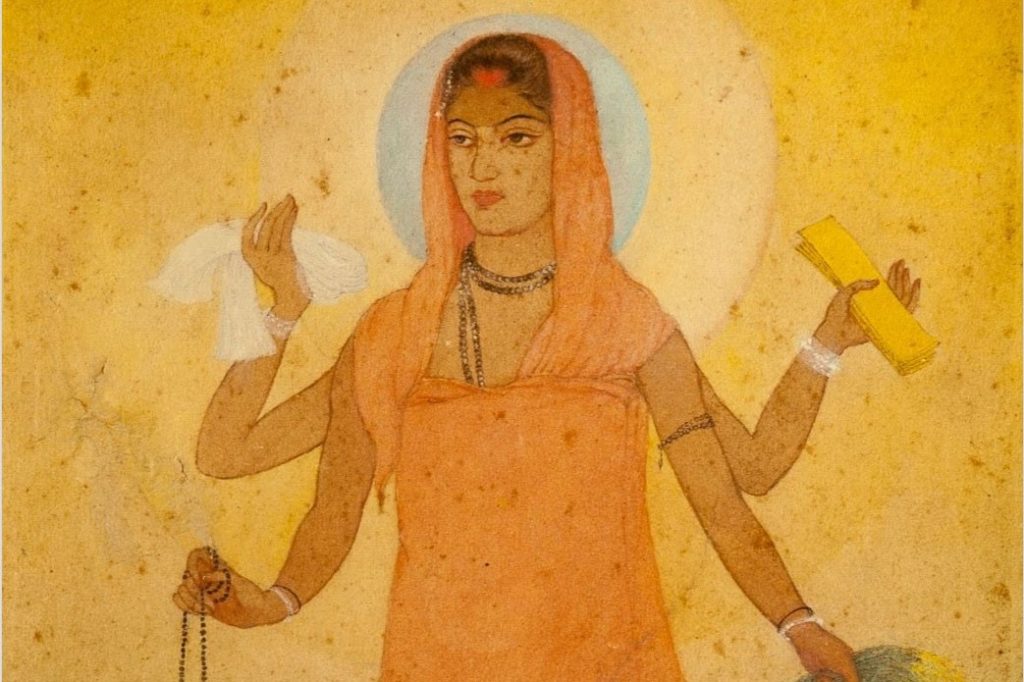By
Tejasvi Saxena
This 1905 painting by Abanindranath Tagore depicts “Bharat Mata” or “Mother India”. Depicted in a tranquil pose, wielding boons to her inhabitants or devotees, the painting humanises a congeries of geographical expressions, encompassing multi ethnic, cultural, linguistic, religious diversities. The tradition of considering every inanimate object as symbolic of veneration, glorifies the idea of Mother India that’s been contemporary and so disputable in today’s context.
The brilliant ideas of India and its dimensions brewed during colonial epoch and afterwards impression the minds of thinkers today. The dialectics of colonialism and nationalism are a complement in itself that has entrenched our notions of asserting faith into such a deep level that we; Indians symbolised India as our mother. Plethora of metaphors, emotional expressions, zeal or idioms may have been employed to indicate India, even its gender identity is decided and being ridiculed due to segregated and self aggrandising interests of ethnicities and occupations.
Ours is a nation where centuries coexist. Against a rural backdrop in vast swathes of green pastures, grazing cows and a string of mud brick huts, even today when a train passes by; innocent eyes of a rural child look in awe of the humongous trail of passengers, sped past by. The veiled women carrying pitchers on meandering by lanes of tiny hamlets are completely oblivious of the immense intensity with which advancement and dependence on technology have entered into the lives of urban Indians.
Since time immemorial, the evolution of mankind has witnessed that any revival or reform is often met by resistance as it is too much an effort to bring change. More difficult is to put up with such a challenge and tread on the path irrespective of tirades against noble ideologies. Be it freedom from tyrannical rule or the courage to chase dreams against all odds, India as being known for its cultural and social eclecticism has always been holding clashes of ideologies in its body politic. The liberal intelligentsia is the proponent of a culture of debate and discussion to interpret, analyse, dissect and deduce the dimensions of truth for civil society and holding onto them for creation of a peaceful nation; anchored on ethos of morality, peace, economic growth and social development.
An idea of ‘Nation’ itself is often questioned by thinkers and intellectuals. Cassandras since the time of India’s independence posited doubts on survival of the biggest democracy in the world; disillusioned by the enormity of problems miring population like illiteracy, unemployment, poverty and health. These very areas in an individual’s life decide his basic sustenance. Until the stomach is empty, no bigger questions of sovereignty, nationalism or secularism could be approached.
Holding together such a unique and incomparable nation is a matter of colossal responsibility. The present government under Prime Minister Narendra Modi and his Cabinet ministry in the last three years of their rule have focused upon inclusive development, sector oriented growth and pumped in vigour; calling out youth of India to participate in making of the nation through skills, knowledge and opportunities being provided through several initiatives by the government to harness their untapped potential and achieving a sense of dignity, pride and self reliance.
However, in the last few years, it cannot be overlooked that a seething disenchantment has brewed in the minds of people. The myopic view to understand cultural and social differences in a land of diversity lingered in minds and actions of ideologues and iconoclastic figures who are eloquent speakers and hold power to sway the young minds and indoctrinate pseudo beliefs that are far away from the truth and only a figment of imagination based upon a partial outlook of understanding things. This disseminated a shallow culture; resulting in merely criticism of the government, without offering alternative remedial measures.
Therefore, it is not surprising to see the hyperactive media, affiliated with its own agendas and ideas showing aberrant truths. A disillusioned youth from Kashmir, holding ISIS flags or stone pelting by a handful of people, captivates the viewers and forms their episodic opinions. However, it cannot be completely ruled out that any area in any nation could not flourish under the decrees ordained upon it by a military force as in Kashmir or North East today in India. The grave miscarriages of justice and human rights violations indeed have taken place, but to paint the entire government and the army as oppressors and fascist forces is an ominous blunder.
The intelligentsia and left liberal thinkers, Democrats and socialists need to mutually cooperate with the government by becoming the voice of the voiceless, and reaching out to the government by constructive suggestions, urging for drawing their immediate attention to the gravity of horrendous issues in India today, such as the rising graph of crimes against women, undercurrents of communal forces felt intermittently, depravity of people in far flung areas and finding measures for an equitable, sustainable and peaceful development in harmony with environment and culture.
On the other side, the government today requires to adopt a soft policy for militancy in Kashmir and Naxalites in the States of Chattisgarh, Jharkhand, Odisha and West Bengal. Using pellet guns against disillusioned stone pelting youths who grew up in turbulence, could not ever suppress their discontent and fury against the Indian army. Innocuous young minds could easily be indoctrinated on lines of religion for giving up their lives in the wake of so called Jehad (Holy War) that arose from a distorted interpretation of Islamic sects like Wahabbism, that translated every non Islamic follower as a Kafir or Sinner; resulting in the persecution of millions of non believers of Islam. Though, Islam which in its originality had accentuated upon virtues of compassion, peace and invoking higher conscience to reach Allah; is sadly clouded.
It’s significant today to allay the fears of youth in the valley, giving them opportunities in ‘mainstream’ India and holding stringent measures to check any violation of human rights in Kashmir by gradually withdrawing forces from the Valley, the appointment of interlocutors and administrative officials by the Centre for supervision and regulation of conduct of the army; ensuring locals lead a life of normalcy without any fear emanating from the Indian army.
It’s high time that the government diplomatically and militarily tackle Pakistan, for consistently thwarting the territorial integrity of India through the infiltration of terrorists in the Valley, and swaying young Kashmiris by luring their depravity with monetary gains to act against India.
The prerogative of Kashmiris to live peacefully in Kashmir should never be jeopardised by letting the disgruntled affair of Kashmir to play in the hands of Pakistan that had been fanning the flames of cessation since 1947.
The other issues in states like Chattisgarh and Jharkhand and Assam facing underdevelopment and inadequacy of stringent law and order for sustenance of Tribal population, are infested with terror activities like extortions, smuggling of arms and human rights violations by the army. The scarcity of resources and lack of trust for the government push the youths of disturbed areas into terror activities; an easy way out to live off on money collected through extortion, the smuggling of arms and looting.
In the northeast, Manipur and Nagaland rebelling for sovereignty; are under the AFSPA, where the military actions are inscrutable and over the years; armed uprisings by locals led to death of forces, naxalites, raping, looting and stark prospects of tribal life.
Amidst all this, What is India for me? In the microcosm of my private, individualised life where does Bharat Mata or Mother India come into being? A ploy for politicians, an abstraction for thinkers, a farce for a manual scavenger or a Dalit, a piece of land or grains of rice for a peasant, a piece of debate for debaters, a representation of demographics for demographers, a map for cartographer, a coin for a numismatist, a stamp for a philologist, a land of culture and aesthetics for an artist or a human body for a painter?
I’m a hell of a lot confused, apparently tight lipped. If somebody asks me ‘What is India for me’, I may glorify its legacy or its composite culture but deep down I know, India’s fabric is fading. Culture of discussion isn’t enough. Maybe looking up to the faces of scholars, activists, unknown multitudes of faces tenaciously working in remote villages, or an honest human being who leads a hard life that goes unnoticed everyday, a struggler who makes ends meet with problems and have a hard time filling bellies of his family with courage and conviction; would give me an answer. They are its essence, their toil is the fragrance of Bharat, or India.
Tejasvi Saxena
Tejasvi Saxena hails from New Delhi, India. A dabbler of photography, a poet in solitude and a thinker in all seasons, he loves the company of books, kids, nature, Music and performing arts. His works have been published in Muse India, Visual Verse, Duane’s PoeTree, Indian Periodical, Dissident Voice Journal, Tuck Magazine, Spillwords, Scarlet Leaf Review, Random Poem Tree, Peeking Cat Poetry, Phenomenal Literature, The Avocet Review and Thumbprint Magazine.



No Comments Yet!
You can be first to comment this post!